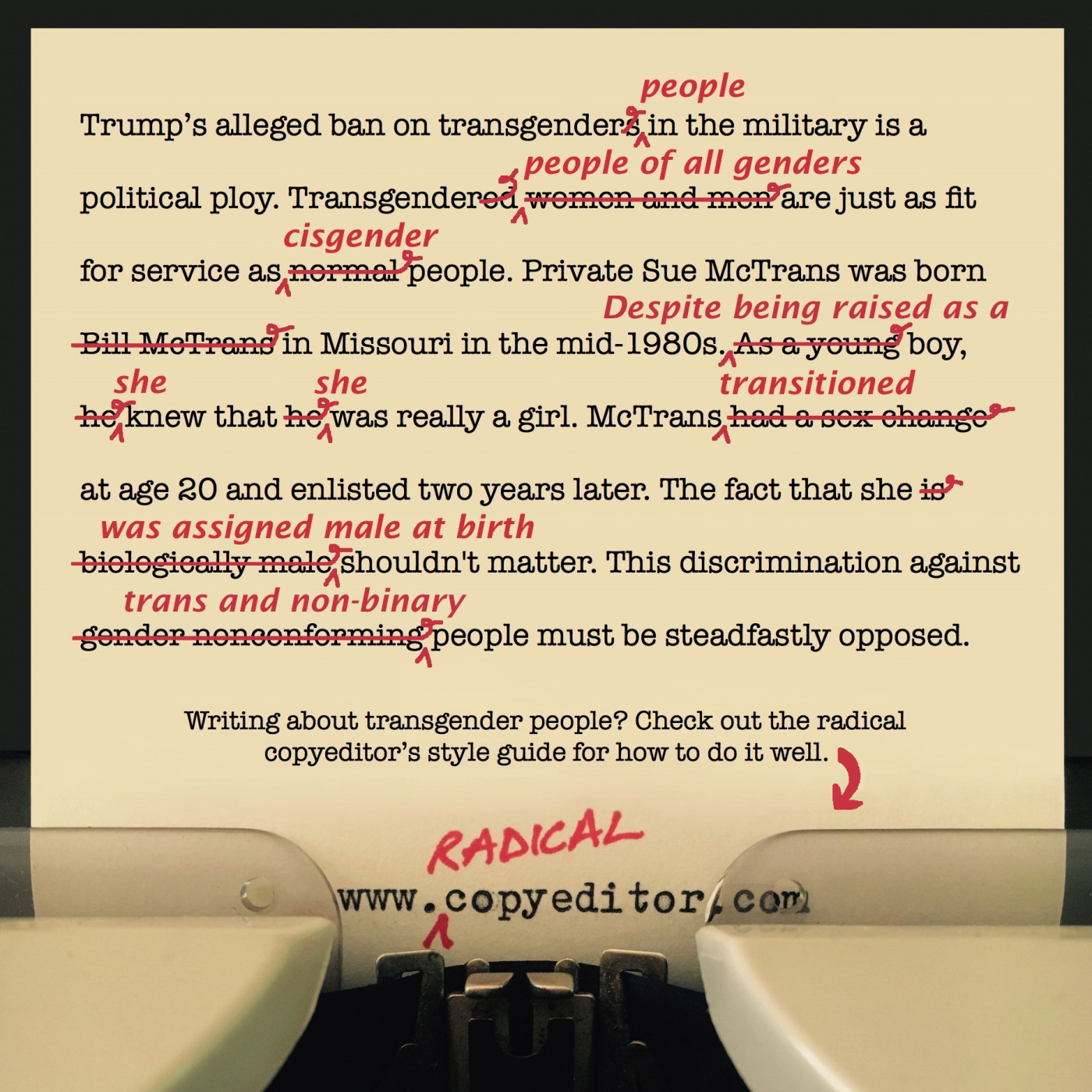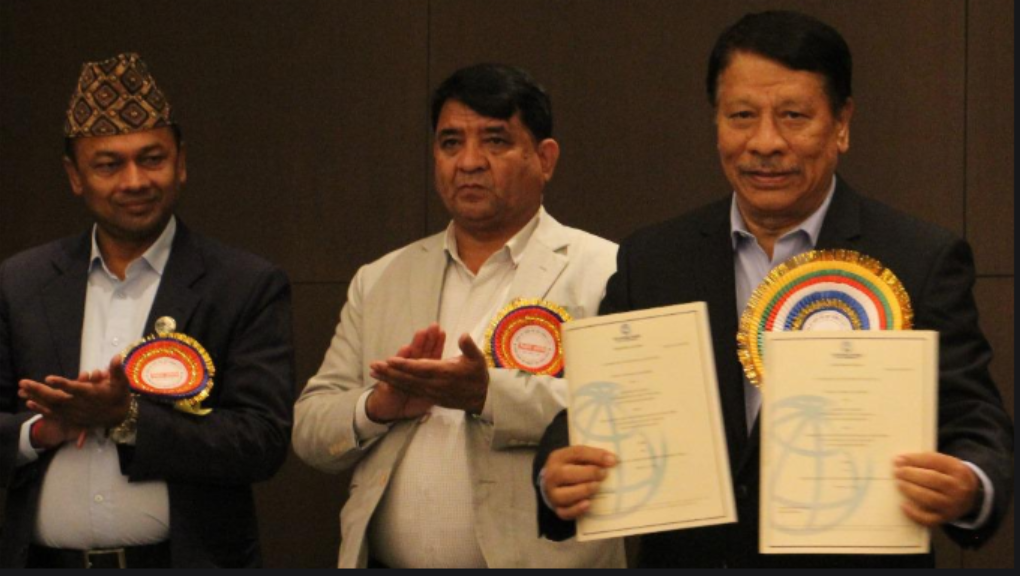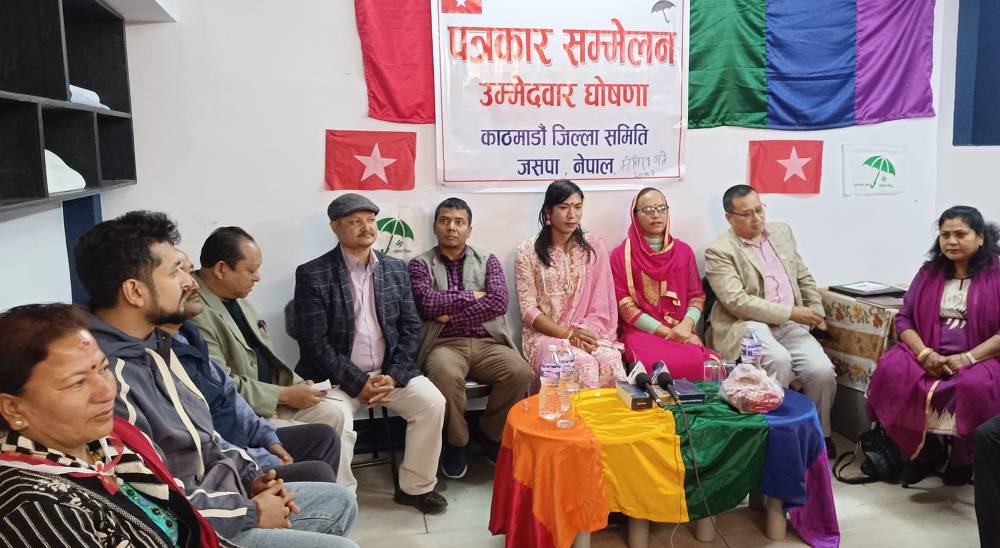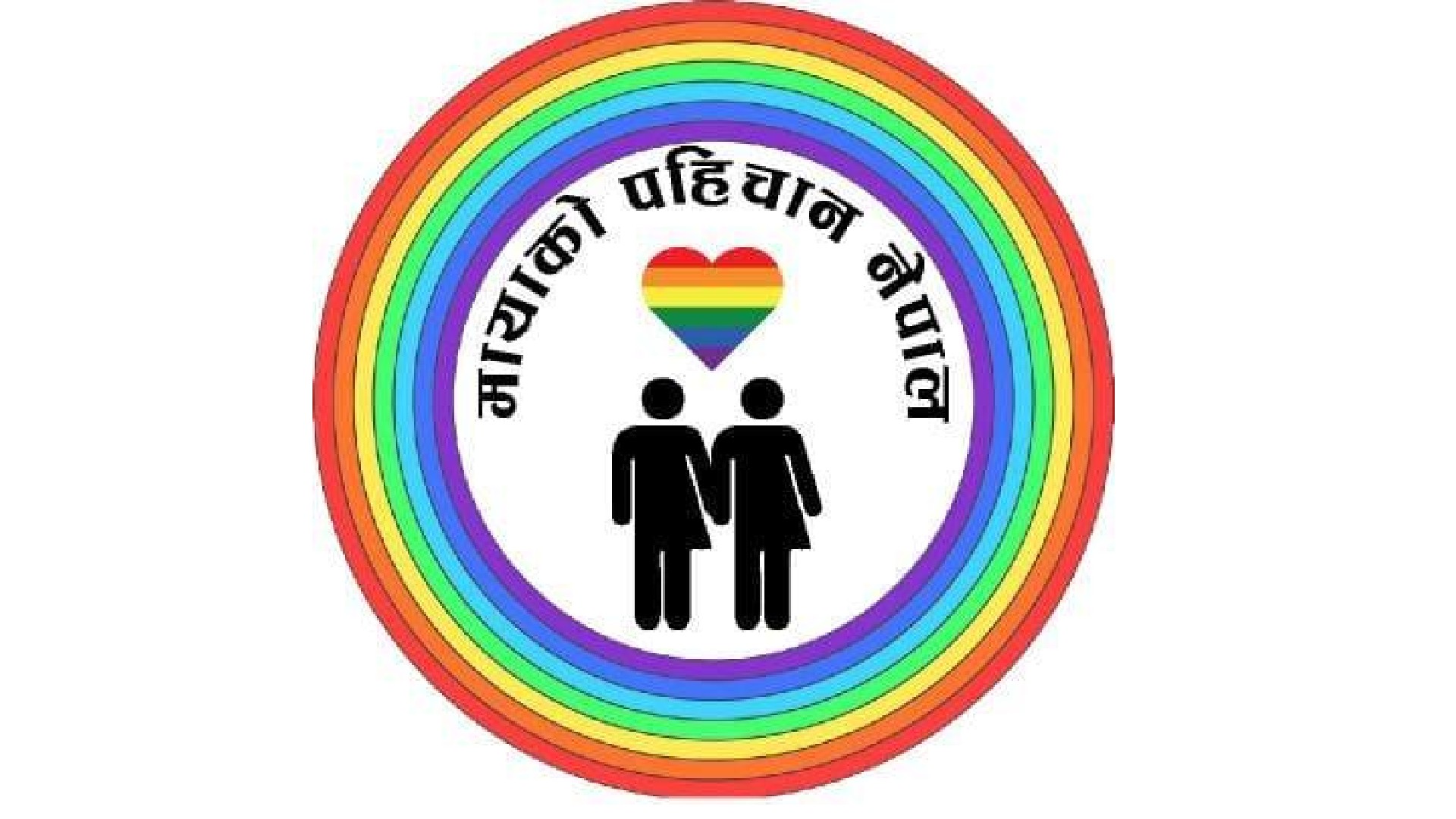Kathmandu (Pahichan) September 4 – A style guide for writing about transgender people is practically an oxymoron. Style guides are designed to create absolutes—bringing rules and order to a meandering and contradictory patchwork quilt of a language. Yet there are no absolutes when it comes to gender. That’s why this is a radical copyeditor’s style guide. Radical copyediting isn’t about absolutes; it’s about context and care.
There are profound reasons for why the language that trans people use to describe ourselves and our communities changes and evolves so quickly. In Western culture, non-trans people have for centuries created the language that describes us, and this language has long labeled us as deviant, criminal, pathological, unwell, and/or unreal.
As trans people have fought for survival, we have also fought for the right to describe ourselves in our own language and to reject language that criminalizes, pathologizes, or invisibilizes us. Just as there is no monolithic transgender community, there is also no one “correct” way to speak or write about trans people.
How to use this guide:
- Treat it as general guidance, not concrete rules.
- Focus on how to practice care toward people whose experience of gender is different from yours.
- Consider context. Language choices completely depend on context: medical environments versus online dating, young children versus elders, USA versus Australia, and so on. Recognize, in particular, that the language used within trans cultural contexts can be far more nuanced than the language outsiders use to describe trans people and trans experiences.
How not to use this guide:
- Do not use this guide to harshly police or shame others’ language choices.
- Do not use this guide to tell trans people that they are using incorrect language, regardless of whether you yourself are trans or not. A general best practice should never supersede a trans person’s right to use whatever language feels best to them.
- Do not care more about words than you do about people.
The purpose of this guide is to help people of all gender identities and experiences practice more care toward those on the margins. Trans people must be understood as the authorities on ourselves and the language used to describe us. Not only does this mean that cisgender (non-trans) people need to practice humility and care toward trans people, but it also means that trans people—particularly those with educational, financial, and/or racial privilege—need to practice humility and care toward other trans people—particularly those who are folks of color, low-income, less educated, and/or elders.
If you are trans, I highly recommend inoculating yourself against the temptation to police other trans people’s language by reading “words don’t kill people, people kill words” and the glossary introduction “there is no perfect word,” both by Julia Serano, as well as “I Was Recently Informed I’m Not a Transsexual,” by Riki Wilchins.
A final note: Like all style guides, what follows is about language usage, not definitions; for a comprehensive glossary of transgender-related terminology, check out this one from Julia Serano.
Transgender Style Guide
Section 1. Correct/current usage of transgender-related language
1.1. Transgender is an adjective.
Use: transgender people; a transgender person
Avoid: transgenders; transgendered
1.2. Transgender is not a sexual orientation.
Correct terms in a transgender context: gender; gender identity and expression
Incorrect terms in a transgender context: sexual identity; sexuality
Avoid: Are you straight, gay, lesbian, bisexual, or transgender (pick one)?
1.3. Transition is the correct word for the social and/or medical process of publicly living into one’s true gender.
Use: Chris transitioned at age 32; the transition process
Avoid: Chris is transgendering; Chris had a sex change; Chris had “the surgery”; Chris became a woman
1.4. Transgender does not refer only to binary-identified trans women and men. Many trans people (35%) are non-binary.*
Use: transgender people; people of all genders
Avoid (in reference to all trans people): transgender women and men
In popular culture, transgender is often exclusively used to refer to binary-identified trans women and men (those who were assigned male at birth and identify as female, or vice versa). Yet transgender actually refers to all those whose gender identities do not align, according to societal expectations, with their birth-assigned sex. This includes non-binary people—those who do not identify (exclusively or at all) as women or men.
Out of respect for the fact that the word transgender is so often used in ways that (incorrectly) do not include non-binary people, it is currently considered a best practice to say transgender and non-binary people when referring to all those whose gender identities are different than what might be expected based on their birth-assigned sex. Yet the word transgender should never be assumed to only refer to binary-identified trans people.
⇒ A note on trans, trans*, and trans+: All three of these terms are used as abbreviations of transgender and/or as ways to more explicitly communicate inclusion of the full breadth of people whose gender identities are something other than was expected of them at birth. Trans* came about in the 1990s and had a huge but relatively brief spurt of popularity in the early 2010s. Trans+ is a more recent variant that plays on the trend of adding a plus sign to terms like LGBTQ to denote greater inclusion.
1.5. The terms gender nonconforming and non-binary are not synonyms.
Gender nonconforming refers to a person whose gender expression (by way of dress, mannerisms, roles, career, and/or lots of other things) does not conform to stereotypical gender expectations for someone of their gender. Examples of gender nonconforming people might include masculine women, effeminate men, women pilots, male ballet dancers, and young girls with short hair.
Non-binary, or gender non-binary, refers to a person whose internal sense of self is not exclusively woman/female or man/male. Some non-binary people identify as both woman and man (e.g., bigender people), some identify as a different gender entirely (e.g., genderqueer people), and some do not identify with any gender (e.g., agender people).
Many people are non-binary in terms of identity and also gender nonconforming in terms of expression, but plenty of other people are only one or the other. It’s important not to use these terms interchangeably.
⇒ A note on gender variant, gender expansive, gender creative, gender diverse, gender fabulous,etc.: Many terms have sprung up over the years to refer to the full spectrum of those who are both gender nonconforming and/or non-binary. Best practices include avoiding terms that carry a negative connotation (e.g., gender deviant), and also avoiding using terms inaccurately (e.g., diverse does not mean “different from the norm,” it just means “varied”—therefore, gender diverse should refer to a group of people with varied genders, not a single person or a group of people whose gender is different from the norm).
1.6. Transgender is a descriptive term, not (usually) a gender and not always an identity.
Use: transgender people; transgender history or identity
Avoid: people who identify as transgender; man, woman, or transgender (pick one)
Transgender means having a gender identity that does not align, according to societal expectations, with one’s birth-assigned sex. Cisgender means having a gender identity that does align with one’s birth-assigned sex. Just as cisgender is a descriptive term, not a gender itself, so too is transgender a descriptive term. Some genders include woman, man, genderqueer, two spirit, agender, and bigender, for example. Transgender is not, for the vast majority of people, a gender, and while some people identify as trans, or as trans women or trans men, others do not consider being trans a part of their identity, and identify solely as genderqueer, or women, or men, for example. Some people describe themselves as a “woman of transsexual experience” or a “man with a history of gender transition,” as additional examples.
Section 2. Bias-free and respectful language in reference to transgender people
2.1. Avoid language that reduces people to their birth-assigned sex or their (assumed) biology.
Use: assigned female at birth; assigned male at birth
Avoid: born a woman; born a man; biologically female; biologically male; genetically female; genetically male; pre-op; post-op
2.2. Avoid treating transgender people as though we have “a condition.”
Use: Monique is transgender; being transgender is not a crime
Use: gender dysphoria
Avoid: Monique has transgenderism; transsexualism/transsexuality is a sin
Avoid: gender disordered; gender identity disorder (outdated)
2.3. Avoid language that puts more value on being or appearing cisgender (not trans), or that carries judgments or biases around how public a person is about being trans.
Avoid: passes; stealth; you’d never be able to tell
Although some transgender people use the terms stealth and passing, it’s not appropriate for non-trans people to use this language unless they are explicitly asked to by a trans person. As Janet Mock has eloquently spoken to, terms like these imply that trans people who are perceived as cisgender (or not trans) are engaging in deception simply by being themselves.
⇒ A note on out and closeted: Coming out is the process of becoming aware of your authentic identity and/or sharing that identity with others. A man who has transitioned is fully out as a man; whether or not he chooses to share his gender history with others is irrelevant. Being closeted means denying one’s identity to oneself and/or others, but if one’s identity is man and one is living life fully as a man, one is out. When a person shares that they have a history of gender transition, that is a disclosure, not an act of coming out.
2.4. Names, pronouns, and prefixes
2.4.1. Always use a person’s correct name, pronouns (or lack thereof), and prefix (if any). Always.
Use: Avery dyed zir hair; Lynn loves their grandson; Monica is her own best advocate; Marcus drove gher car with care; Xander tied hir shoes; Sam ate Sam’s lunch at Sam’s apartment
The first and foremost way to respect and honor a transgender person’s personhood is to respect the language they use to refer to themself. Transgender people have been forced to forge new paths in language in order to carve out space for our very existence. Because there are more than two, three, four, or five genders in the world, there are more than two, three, four, or five pronouns, and all are equally valid—including some people’s choice to be referred to using no pronouns at all.
2.4.2. Using a transgender person’s birth name or former pronouns without permission (even when talking about them in the past) is a form of violence.
Use: Bridget knew from the age of 3 that she was a girl.
Avoid: At the age of 3, Bob announced that he was a girl. After transitioning, Bob—now Bridget—threw out her old clothes.
Some transgender people do use a different name and/or pronouns to talk about themselves prior to transition, but this is rare. Unless you are told differently, only use a person’s true/current name and pronouns, even when writing about them in the past.
2.4.3. Pronouns are simply pronouns. They aren’t “preferred” and they aren’t inherently tied to gender identity or biology.
Use: pronouns; she/her/hers; he/him/his; they/them/theirs; ze/zir/zirs; Sam/Sam/Sam (and any other pronoun or combination)
Avoid: preferred pronouns; masculine pronouns; feminine pronouns; male pronouns; female pronouns
As J. Mase III once succinctly put it, “my pronouns aren’t preferred; they’re required.” A person’s correct pronouns are not a preference; neither are pronouns inherently masculine, feminine, male, or female: for example, a masculine person could use she/her/hers pronouns and a female person could use they/them/theirs pronouns.
2.5. Respect the diversity of language that people use to describe themselves.
It is a human tendency to try to make sense of the world by categorizing things, including people—but gender, in its true diversity, defies categorization. Biology is incredibly varied, and the meaning we draw from it is even more so. As noted in the introduction to this guide, transgender people must be understood as the ultimate authorities on ourselves and the language used to describe us, even when doing so goes against things like style guides (this one or any other). When writing or talking about an individual person, this means finding out what language that person uses to describe themself and never assuming what language is correct or best without asking. Something as seemingly small as the difference between trans man and transman can have enormous significance to a person.
2.6. Practice particular sensitivity around culture-specific language related to gender identity and expression.
Gender is culturally constructed, which means that there isn’t a set, finite number of gendered experiences that transcend language; rather, cultural context is everything when it comes to gender. For example, two spirit is a beautifully complex term that doesn’t entirely translate outside of North American Indigenous cultures; just as terms like hijra, māhū, fa’afafine, and many others aren’t fully translatable outside their cultural contexts. Similarly, terms like stud and aggressive are terms that are specific to Black culture.
Historical context is also important. For example, it’s undeniable that Joan of Arc did not conform to the gender norms of her day, but describing her as transgender isn’t accurate, because today’s cultural understanding of what transgender means can’t be applied to people from a different era without knowing how they understood themselves in their own context.
Section 3. Sensitive and inclusive broader language
3.1. Recognize that there are more than two genders. Embrace “singular they” and avoid the language of gender opposites.
Use: Honor each person’s truth about their identity; everyone; people of all genders; siblings; kindred
Avoid: Honor each person’s truth about his or her identity; men and women; the opposite sex; both genders; brothers and sisters
Using they/them/theirs to refer to a person whose gender is unknown has a long and fairly consistent history in the English language, and many people have documented how using they in both singular and plural fashion is grammatically correct, just as you can be used in both singular and plural fashion. Doing so is an essential way to create linguistic space for the existence of non-binary people.
3.2. Do not use LGBTQ or its many variants (LGBT, LGBTQIA+, etc.) as a synonym for gay.
Use: LGBTQ people versus non-LGBTQ people
Avoid: LGBTQ people versus straight people
If you’re using an acronym that includes transgender people, it’s important to actually include trans people in the context of what you are writing about. For example, if you’re only writing about people in same-sex relationships, or if you’re trying to refer to everyone with a marginalized sexuality, don’t use LGBTQ. Some transgender people (15%) identify as straight.* LGBTQ and straight/heterosexual are not, therefore, opposites, and should never be treated as such.
3.3. Recognize queer as a valid sexual orientation.
More transgender people identify as queer (21%) than any other sexual orientation.* Although mainstream style guides and dictionaries have refused to recognize the evolution of this word, writing sensitively about transgender people requires honoring the language we use to describe not only our genders but also our sexualities. Queer is a complex word with many different definitions, and in the context of transgender communities, it must be recognized as a valid identity term.
3.4. Embrace the fact that language can evolve quickly.
The language of gender identity and expression is evolving at lightning speed. This can easily feel overwhelming to some people and results in every sort of reaction, from knuckling down and resisting language changes to throwing up one’s hands in despair to becoming judgmental or dismissive of new (or old) words and the people who use them.
There’s another way. Choose to celebrate this rapid evolution of language because of what it means: that people who have been marginalized for centuries are finding ways of reclaiming agency and legitimacy; that those of us who have been written out of existence are finding ways to rewrite reality to make room for our true selves. The purpose of language is to communicate, not to regulate.
A final note
A style guide can never serve as a replacement for being in relationship with the real people you are writing about. If you are writing about transgender people—whether you yourself are trans or not—always do so from a place of relationship. Don’t assume; ask. Always bring in additional trans perspectives on what you’ve written—across lines of gender, age, race, class, ability, and sexuality. Never fall for the trap of thinking that a single trans person can represent or speak for the breathtaking diversity of all of those who are encompassed by the word transgender. If you do nothing else, this one thing will always steer you right.
Copy : https://radicalcopyeditor.com













